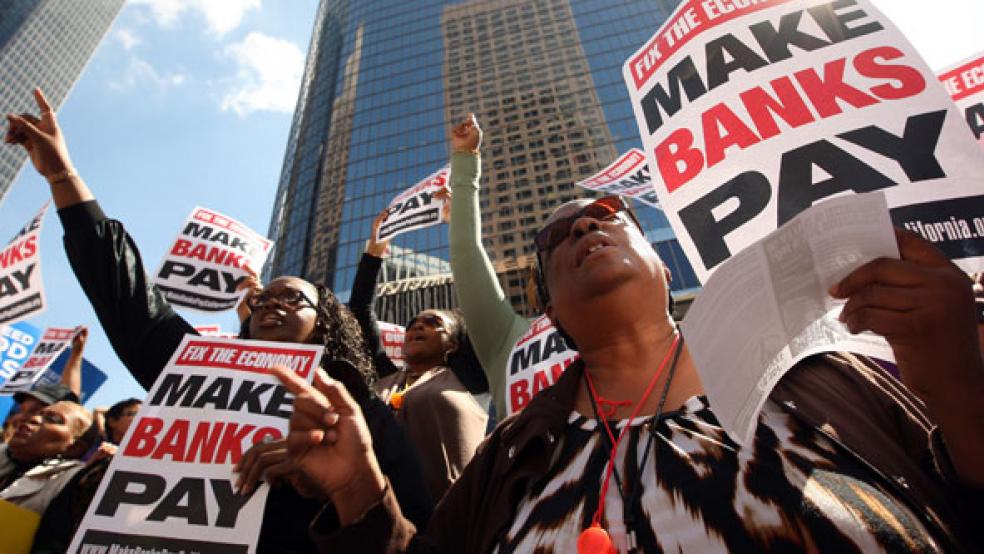The debate is raging on Capitol Hill over whether the era of ‘too big to fail’ banks has truly ended. Now, one player has emerged who might finally answer the question that has dogged Wall Street and lawmakers ever since Lehman Brothers went belly up in 2008.

It’s not a big name. Others have been in the spotlight when discussing whether the 2010 Dodd-Frank reforms actually reinforced taxpayer-funded safety nets for Wall Street, instead of removing them as intended.
Attorney General Eric Holder indicated last month that criminal charges against a powerful bank might destabilize the markets. Fed Chairman Ben Bernanke conceded to reporters a few weeks ago that the problem of ‘too big to fail’ persists, even if regulators have made some progress in introducing new controls. “It is not solved and gone,” Bernanke said. “[It’s] a real problem and needs to be addressed if at all possible.”
In the Senate, Democrat Sherrod Brown of Ohio and Republican David Vitter of Louisiana are pairing up on a new bill to limit the size of the country’s biggest banks. Dallas Federal Reserve Bank president Richard Fisher is crusading around the country with his own plan to do the same. Thomas Hoenig, vice-chairman of the Federal Deposit Insurance Corporation, penned an op-ed in last Friday’s Washington Post that the government subsidizes the nation’s largest banks.
Nope. Not a big name at all, even though it could help to settle the debate by virtue of its data-driven philosophy.
THE $100 MILLION MAN
Few Americans have heard of the Office of Financial Research—and even some DC insiders occasionally forget about the $100 million-plus agency created by Dodd-Frank. It lacked a director until the start of this year, when Richard Berner—previously one of the top economists for Morgan Stanley and a counselor for former Treasury Secretary Tim Geithner—received a long-awaited Senate confirmation.
It could be Berner's work over his six-year term that determines whether ‘too big to fail’ is over or more dangerous than ever. The trouble is that the office—which is contained inside the Treasury Department—has been slow to get on its feet as the controversy smolders.
“They’ve been in the process of setting up for a couple of years,” explained a former Senate staffer involved in the crafting of Dodd-Frank who agreed to detail the state of play on background. “I’d really like to see the OFR live up to the potential that was established for it in the statute. … We’re just missing a very important voice.”
The mission at the Office of Financial Research is to track previously hidden financial data and identify potential risks to the economy, a process that requires the agency to develop an unprecedented system for monitoring in real-time Wall Street and its darkest of alleys.
Before the 2008 financial crisis, regulators essentially tried to oversee the markets by looking through the rearview mirror. The shortage of real-time information made it difficult for regulators to fully understand the problems of mortgage-backed securities and the highly-leveraged firms with a web of vast, unseen connections.
Through its research and analysis, the OFR can report independently to Congress on dangerous patterns in the markets. It also advises the Financial Stability Oversight Council—the group of 10 federal regulators responsible for overseeing the companies that might pose a threat to the entire financial system.
BANK DATA: TOO BIG TO NAIL?
The current debate about ‘too big to fail’ is missing a referee, a data wonk to fact-check the hailstorm of statistics that get thrown about. Plenty of competing studies have been produced on ‘too big to fail,’ but nothing definitive enough to set another change in policy since 2010. The trouble is that the OFR is still in its embryonic stages.
“This would be a perfect topic for an independent, nonpartisan, disinterested, dispassionate organization to do some serious research into the size and origin of the purported cost of funding advantage,” said John Dearie, executive vice president for policy at the Financial Services Forum, which represents 19 of the sector’s largest companies. “It’s unfortunate that they’re not at the place in terms of resources and manpower to contribute to this debate.”
The OFR currently has about 140 staffers, half the number envisioned for this year under past budget proposals. For now, its major initiative involves finalizing a unique code—known as a Legal Entity Identifier—to detect exactly which firms are involved in individual trades before the end of 2013, a key tool the government does not currently have. The office is also studying asset management firms and the markets for the short-term funding of companies.
The OFR noted in its annual review last summer that ‘too big to fail’ persisted as a risk to the economy, but its synopsis added little to the conversation.
Berner struggled in part to receive confirmation because some Republican lawmakers feared that the agency could adopt a Big Brother-like surveillance of the markets.
The University of Pennsylvania PhD takes to the job confident that the situation has improved, even though just 37 percent of the rules attached to Dodd-Frank have been finalized.
“In fact, the adoption of financial reforms here and abroad has, in my view, brightened the financial risk outlook, and I am more optimistic as a result,” Berner said in a speech last month at a risk management convention, saying that banks are relying less on leverage and the markets are more transparent after Dodd-Frank.
THE BREAK-UP ARGUMENT
The stock market may be eclipsing its previous highs, but a huge political appetite still exists for breaking up the largest financial institutions out of concern that they are simply too complex and gargantuan for anyone to oversee. That argument was even championed last year by Sandy Weill, the architect of the merger that formed Citigroup.
This appeals on a populist level to those who still feel slighted about Wall Street executives getting taxpayer-funded bonuses as millions of homeowners faced eviction.
When Dallas Fed President Fisher talked up his plan to keep Wall Street off the public dime, he stopped by the Conservative Political Action Conference best known for its straw poll of GOP presidential contenders. Sen. Elizabeth Warren, D-Mass., who came to office with a reputation to fight banks, picked up media coverage at a Senate Banking Committee hearing where she grilled Bernanke about government preferences for larger financial institutions.
Fears about another bailout persist because many of the nation’s largest banks have grown after the 2008 meltdown, in part through mergers with institutions such as Bear Stearns that were on the verge of collapse.
Federal filings indicate that a dozen institutions control 69 percent of all banking assets—with the biggest players being JPMorgan Chase, Bank of America, Citigroup, Wells Fargo and Goldman Sachs.
Dodd-Frank embraced tighter capital controls and living wills for institutions that in theory pose a systemic threat—including all banks with $50 billion in assets. By having the living wills, the companies can supposedly be liquidated without a government bailout or economic disruption. But critics of the law note that the government may have inadvertently signaled to the markets which institutions could be ‘too big to fail’ by requiring the living will.
Hoenig at the FDIC and Brown in the Senate stress that a regime of government guarantees—deposit insurance, loans from the Fed, and the precedent of the previous $800 billion rescue under the Troubled Assets Relief Program—mean that large banks might still enjoy advantages in funding and take economy-wrecking risks at taxpayer expense.
When Warren sharply questioned Bernanke on the issue, she relied on an analysis by the International Monetary Fund about mega-banks being able to borrow at cheaper rates than their competitors because of indirect government backing.
Five of the financial industry’s largest associations—including the American Bankers Association and the Financial Services Forum—quickly criticized her conclusion as inaccurate because the study relied on estimates from 2007 to 2009 that pre-dated the passage of Dodd-Frank.
When given a chance to offer his perspective on the matter last month, Berner decided not to weigh in, deferring instead at a House Financial Services subcommittee hearing on oversight and investigations to the opinion of Amias Gerety, the Treasury Department’s deputy assistant secretary for the Financial Stability Oversight Council.
Freshman Rep. John Delaney, D-Md., asked on March 14 if either entity was studying whether the markets perceive the government as having stopped ‘too big to fail.’
Berner stayed silent and let Gerety answer the question.
“That perception, if it exists, is incorrect,” Gerety said. “We’re aware of the debate, but the action of Dodd-Frank does not allow that perception to become a reality.”




